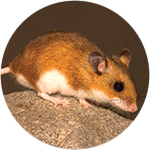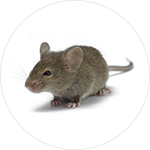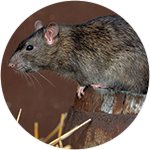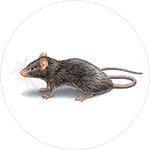Deer Mouse

Color: Brown with white feet and underbelly. Tail is bicolored with white on the bottom.
Legs: 4
Size: 5/8 – 3/4 inch long
Region: Found throughout the U.S.
Habits
Deer mice often nest in old fence posts, tree hollows, log piles, abandoned bird nests and beneath decks. During winter months, they may invade businesses, homes, garages, sheds or rarely used vehicles to seek shelter. Inside, they can make their nest in storage boxes, stuffed furniture, drawers, wall voids and tight areas. Deer mice feed at dusk and dawn, preferring insects, seeds, nuts, berries and small fruits.
Habitat
The deer mouse makes its home outdoors. Sheltered areas such as hollow tree logs or piles of debris make the ideal deer mouse habitat. On the rare occasions the deer mouse comes indoors, it prefers undisturbed areas such as attics.
Threats
Deer mice are a medical concern because they are the common carrier of Hantavirus. This virus is transmitted primarily by the inhalation of dust particles contaminated with the urine, feces or saliva of infected deer mice.
Prevention
To keep deer mice and other rodents out, make sure all holes of larger diameter than a pencil are sealed. Mice can squeeze through spaces as small as a dime. Seal any cracks and voids. Clearing of overgrown shrubs and weeds can help make the exterior of structures less inviting to deer mice. Keep wood piles away from structures. Use heavy gloves and protective breathing gear when working in an enclosed area populated by deer mice.
House Mouse

Color: Dusty gray or brown with a cream belly
Legs: 4
Size: 1/4 – 1/8 inches long (5 – 7 inches long with tail)
Region: Found throughout the U.S.
Habits
House mice are excellent climbers and can jump up to a foot high. They prefer to eat seeds, grain and insects, but will eat many kinds of food.
Habitat
House mice live in structures, but they can survive outdoors, too. House mice prefer to nest in dark, secluded areas and often build nests out of paper products, cotton, packing materials, wall insulation and fabrics.
Threats
Micro droplets of mouse urine can cause allergies in children and they are associated with several other diseases including some pathogens which cause food borne illness. Mice can also bring fleas, mites, ticks and lice into your home or business.
Prevention
To keep mice and other rodents out, make sure all holes of larger diameter than a pencil are sealed. Keep areas clear and store boxes off of the floor because mice can hide in clutter. Regularly inspect for signs of mice including droppings, gnaw marks and damaged food goods. If you suspect a rodent infestation, contact a licensed rodent pest control professional to treat and get rid of house mice.
Norway Rats

Color: Brown with scattered black hairs; gray to white underside
Legs: 4
Shape: Long heavily bodied, blunt muzzle
Size: 7 – 9 1/2 inchs in length
Region: Found throughout the U.S.
Habits
Norway rats are primarily nocturnal. Outdoors, they burrow in soil near stream/river banks, piles of garbage or under concrete slabs. Norway rats are social and often build burrows close to one another. Indoors, they often nest in basements, piles of debris or undisturbed materials. They are known to gnaw through almost anything – including plastic or lead pipes – to obtain food or water. They will feed on a wide variety of different foods but tend to prefer grains, meats, fish, nuts and some types of fruits. They require ½ ounce to one ounce of water each day but may be able to survive on less water if moist foods are available.
Habitat
Outdoors, Norway rats live in fields, farmlands and in structures. These rats frequently burrow in soil near riverbanks, in garbage and woodpiles, and under concrete slabs. Indoors, Norway rats often nest in basements, piles of debris or undisturbed materials. Rodents can gain entry to a home or business through a hole the size of a quarter.
Threats
Norway rats can cause damage to structures through their gnawing and eating. These rats are also vectors of diseases including plague, jaundice, rat-bite fever, cowpox virus, trichinosis and salmonellosis. In addition, Norway rats can contaminate food and introduce fleas into a home or business.
Prevention
Norway rats are often drawn to piles of wood, so homeowners should keep firewood stored well away from the structure and remove debris piles to reduce nesting spots. Norway rats can enter structures when there are openings ½” in size (size of a quarter). Seal openings and door thresholds to this level. Eliminate sources of moisture, especially in crawl spaces and basements, to get rid of Norway rats. It’s also important to occasionally inspect for signs of a Norway rat infestation, including rodent droppings, gnaw marks, damaged goods and greasy rub marks caused by their oily fur.
Roof Rat

Color: Brown with black intermixed; gray, white or black underside
Legs: 4
Shape: Long and thin with scaly tail; large ears and eyes
Size: 6 – 8 inches in length (16 inches long with tail)
Region: Coastal states and the southern third of the U.S are the most common locations but may be transported further north
Habits
Roof rats are primarily nocturnal. They live in colonies and prefer to nest in upper parts of structures or in trees. They forage for food in groups of up to ten and tend to return to the same food source time after time. Roof rats often follow the same pathway between their nest and food. Their runways will be free of debris and may also have dark rub marks where their fur makes contact.
Habitat
Roof rats live in colonies and prefer to nest in the upper parts of buildings. They can also be found under, in and around structures.
Threats
Historically, roof rats and their fleas have been associated with bubonic plague. Roof rats can also spread typhus, jaundice, rat-bite fever, trichinosis and salmonellosis. They can also carry fleas and mites.
Prevention
To get rid of roof rats and prevent them from entering a structure or home, seal up any holes or cracks larger than a quarter. It is important to conduct sealing efforts both at ground level and roof line since these rats are excellent climbers. Keep trees and shrubs trimmed away from the structure and cut back limbs overhanging the roof. Roof rats are drawn to any accessible food sources, so clean up fruit that may fall from trees and keep garbage in tightly covered receptacles. It’s also important to regularly inspect the property and home for signs of a roof rat infestation, including rodent droppings, gnaw marks, damaged goods and greasy rub marks from their oily fur.
